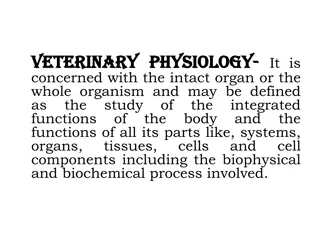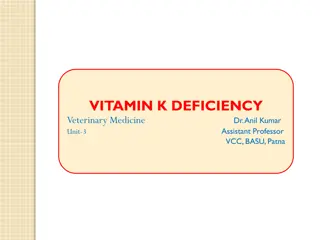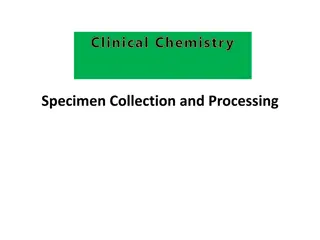The Main Factors That Influence the Consumer Buyer Behavior
Consumer buyer behavior is influenced by various factors such as cultural, social, personal, and psychological elements. Culture, social factors like family and opinion leaders, personal factors such as age, occupation, lifestyle, and personality, as well as psychological factors like motivation, pl
2 views • 8 slides
Understanding Bleeding Time and Coagulation Time Tests
The Bleeding Time (BT) test evaluates platelet plug formation and capillary integrity, crucial for surgery preparations. Prolonged bleeding times indicate low platelet count or dysfunction. The Duke method is one way to determine Bleeding Time. Sources of error, such as medication interference, impr
5 views • 8 slides
Understanding Blood Clotting Factors in the Human Body
Blood clotting factors play a crucial role in the coagulation process to prevent excessive bleeding. Factors such as Fibrinogen (Factor-I), Prothrombin (Factor-II), Thromboplastin (Factor-III), Calcium Ions (Factor-IV), Labile Factor (Factor-V), and Stable Factor (Factor-VII) are essential for the c
7 views • 14 slides
Understanding Coagulation Profile in Hemostasis
Coagulation profile testing is crucial in assessing blood clotting ability. The process of coagulation is essential for hemostasis to prevent bleeding or clotting disorders. This summary explores the steps involved in hemostasis, the clotting cascade, and the triggers for the extrinsic and intrinsic
6 views • 14 slides
Anagrelide 0.5mg: An Effective Treatment for Essential Thrombocythemia
Efficacy and Dosage Efficacy & Dosage Efficacy of Anagrelide (0.5mg) What is Anagrelide? Essential thrombocythaemia is a condition in which an excessive amount of platelets are present in the blood. Anagrelide 0.5 mg inhibits the production of platelets, thereby reducing the risk of blood clotting,
0 views • 3 slides
Analysis of Individual Risk Factors in Ventral Hernia Repair Outcomes
This study explores the impact of various risk factors on predicting adverse outcomes of ventral hernia repair using data from the Abdominal Core Health Quality Collaborative (ACHQC). The research aims to quantify and compare the influence of different factors, hypothesizing that hernia- and procedu
0 views • 14 slides
Understanding Vitamin K: Types, Sources, and Functions
Explore the types and dietary sources of vitamin K, including Phylloquinone and Menaquinone. Discover the essential role of vitamin K as a coenzyme in the synthesis of prothrombin and blood clotting factors such as II, VII, IX, and X through carboxylation. Learn about the recommended daily allowance
1 views • 21 slides
Understanding Blood Groups, Clotting Time, and Bleeding Time in Medical Practice
This informative material delves into the significance of determining blood groups, clotting time, and bleeding time in medical settings. From explaining the ABO and Rhesus systems to outlining the practical objectives and procedures for the assessments, this resource aims to enhance understanding o
0 views • 34 slides
Overview of Chemical Mediators of Inflammation and Their Roles
Chemical mediators of inflammation act on blood vessels and cells to contribute to an inflammatory response. These mediators include vasoactive amines like histamine and serotonin, plasma proteases such as the complement, kinin, and clotting systems, and important inflammatory mediators like C3a and
1 views • 24 slides
Understanding Blood Cells and Transport Mechanisms
Your blood, consisting of red blood cells, white blood cells, platelets, and plasma, plays a crucial role in transporting substances like oxygen, nutrients, and waste products throughout your body. Red blood cells are specialized for oxygen transport due to their unique adaptations, while white bloo
2 views • 18 slides
Hemostasis and Blood Coagulation Mechanisms Explained
Hemostasis refers to the prevention of blood loss through vascular constriction, platelet plug formation, blood clotting, and fibrous tissue growth. Vascular constriction occurs immediately after vessel damage, initiated by myogenic spasm, autacoid factors, and nervous reflexes. Platelet plug format
0 views • 25 slides
Understanding Hemostasis: Key Concepts in Blood Clotting Mechanisms
Hemostasis, crucial for preventing blood loss, involves platelet formation, clotting factors, and fibrinolysis. This process includes vessel constriction, platelet activation, clot formation, and fibrin breakdown. Platelets, produced in the bone marrow, play a vital role in maintaining vascular inte
0 views • 33 slides
Understanding Environmental Factors in Terrestrial and Aquatic Environments
Environmental factors play a crucial role in shaping ecosystems. In both terrestrial (land) and aquatic (water) environments, organisms are influenced by abiotic factors such as temperature, light intensity, and pH, as well as biotic factors like plants, predators, and competitors. Understanding the
4 views • 19 slides
Factors Affecting Microbial Growth in Food: Intrinsic and Extrinsic Factors
In food, microbial growth is influenced by intrinsic factors like pH, water activity, nutrient content, and extrinsic factors such as environmental conditions. The pH level, moisture content, and water activity play crucial roles in determining the growth of microorganisms, with specific ranges affe
1 views • 23 slides
Understanding Coagulation Profile: A Comprehensive Overview
Coagulation is a crucial process in hemostasis that involves clot formation. This profile delves into estimating clotting time, bleeding time, and prothrombin time to assess coagulation status. Explore the mechanisms of hemostasis, clotting cascade, triggers of intrinsic and extrinsic pathways, and
0 views • 12 slides
Understanding Platelet Count and its Importance in Blood Clotting
Platelets, also known as thrombocytes, play a crucial role in blood clotting. This article explains the structure and lifespan of platelets, the purpose of performing a total platelet count, and the principle of counting platelets using a hemocytometer. It also describes the components used for plat
0 views • 20 slides
Overview of Inflammatory Diseases of Bone
Inflammatory diseases of bone encompass conditions like osteitis, osteomyelitis, periostitis, and alveolar osteitis (dry socket). Osteitis is localized and may be associated with infected sockets, while osteomyelitis involves the interior of the bone. Alveolar osteitis commonly follows tooth extract
0 views • 20 slides
Factors Influencing Customer Choice: Psychological, Sociocultural, Economic, and Government Factors
Psychological factors, such as perception and lifestyle, play a key role in customer choice. Sociocultural influences from society and culture also impact decisions, while economic factors like income levels and government policies can sway customer preferences. Understanding these factors is crucia
0 views • 18 slides
Understanding Anticoagulants in Laboratory Hematology
Anticoagulants are crucial additives that prevent blood clotting during laboratory procedures. The commonly used anticoagulants include EDTA, sodium citrate, and heparin, each with specific concentrations, modes of action, and color-coded identifications. EDTA is ideal for blood cell counts, sodium
0 views • 6 slides
Understanding Anticoagulants Used in Hematology Laboratory
Anticoagulants play a crucial role in hematology by preventing blood clotting, allowing separation of blood components, with EDTA being the most commonly used anticoagulant. Proper blood-to-anticoagulant ratio is essential to avoid inaccuracies in results, such as falsely reduced hematocrit or erron
0 views • 10 slides
Understanding Veterinary Physiology and the Functions of Blood
Veterinary physiology involves studying the functions of intact organisms, organs, tissues, and systems. Blood, consisting of plasma and formed elements, plays vital roles in nutrient transport, gas exchange, waste removal, hormone distribution, temperature regulation, water balance, pH maintenance,
0 views • 29 slides
Comprehensive Guide to Factorization in Mathematics
Explore the concept of factorization in algebraic expressions, including the definition of factors, common factors, methods of factorization, and illustrated examples. Learn about finding factors, common factors, and various factorization techniques such as common factors method and regrouping of te
0 views • 13 slides
Insights into Liver Anatomy, Function, and Imaging Studies
Delve into a comprehensive overview of the liver's anatomy, including ligaments, blood supply, and structure in the hilum. Explore the vital functions performed by the liver, such as maintaining body temperature, synthesizing clotting factors, and drug metabolism. Discover liver function tests and t
3 views • 22 slides
Understanding Vitamin K Deficiency in Veterinary Medicine
Vitamin K deficiency in animals can lead to serious health issues due to its crucial role in blood clotting and bone metabolism. Different sources of vitamin K, such as plant material and bacterial fermentation, provide essential forms like K1 and K2. Factors contributing to deficiency include fat m
0 views • 8 slides
Overview of Cardiac Medications and Their Effects
This comprehensive guide covers various types of cardiac medications including anticoagulants, antiplatelet drugs, thrombolytics, and beta-blockers. It details their mechanisms of action, dosage guidelines, side effects, and contraindications. Anticoagulants prevent blood clotting, antiplatelets inh
0 views • 20 slides
Aintree Dialysis Unit - KQUIP Magic Project Data Analysis Jan-June 2020
Analysis of data from January to June 2020 at the Aintree Dialysis Unit under the KQUIP Magic Project reveals issues with needle clotting and flow disruptions. Lessons learned include priming needles with saline and seeking help when needed. Efforts to sustain the project involve staff education, pa
0 views • 7 slides
Understanding the Oxford-AstraZeneca Vaccine: Benefits, Risks, and Recommendations
The Oxford-AstraZeneca vaccine has shown a likely but unproven link to cerebral venous sinus thrombus and other blood clotting issues. Despite this, the benefits of vaccination still outweigh the risks, with only approximately 4 cases per million resulting in death. Communication of the potential be
0 views • 10 slides
Snake Bite Management Guidelines: Reassurance, Immobilization, Hospital Care
Snake bite management involves reassuring the victim, immobilizing the affected limb, and promptly transporting the individual to a hospital with snakebite treatment facilities. Local and systemic examinations are essential to assess the severity of envenomation, followed by necessary investigations
0 views • 12 slides
Understanding Antiphospholipid Antibody Syndrome and Its Clinical Implications
Antiphospholipid antibody syndrome is an acquired disorder characterized by recurrent thrombosis or pregnancy complications due to autoantibodies against phospholipid-binding plasma proteins. Learn about its classification, epidemiology, pathogenesis, and diagnostic antibodies. Discover how lupus an
0 views • 35 slides
Ecological Factors and Climatic Influences on Plant Life
Ecological factors play a crucial role in shaping the environment for organisms to thrive. This includes living (biotic) and non-living (abiotic) components like climatic factors, edaphic factors, topographic factors, and biotic factors. Climatic factors such as light, temperature, water, wind, and
0 views • 14 slides
Understanding Blood Composition and Functions in Medical Physiology
Blood, a vital fluid tissue in the cardiovascular system, plays crucial roles in transportation, regulation, and protection. Comprised of cellular and non-cellular components suspended in plasma, it facilitates the transport of gases, nutrients, hormones, and waste products, regulates temperature, p
0 views • 22 slides
The Importance of Dairy Products for Your Health
Dairy products are essential for providing nutrients like calcium, vitamin D, and protein. They help in bone and muscle health, blood clotting, and nerve function. If you are lactose intolerant, there are alternative sources to get calcium. Meeting the recommended daily allowance of calcium is cruci
0 views • 11 slides
Understanding Factors and Prime Factors in Mathematics
Explore the concept of factors and prime factors through practical scenarios involving Jedward, stationary supplies, and school choirs. Learn how to find factors of numbers like 18 and 30, identify prime numbers, write numbers as products of prime factors, determine common factors, and calculate low
0 views • 19 slides
Understanding Anticoagulants: Mechanisms, Indications, and Limitations
Anticoagulants play a crucial role in preventing blood clotting and are used in various medical conditions such as myocardial infarction and deep venous thrombosis. They include heparin, warfarin, and antiplatelet agents like aspirin. This article explores the mechanisms of action, indications, and
0 views • 29 slides
Clinical Chemistry Specimen Collection and Processing Overview
Clinical chemistry specimen collection involves obtaining blood samples for analysis. Serum and plasma are commonly used specimens, each requiring specific handling. Different anticoagulants like heparin are used to prevent blood clotting during sample processing. Heparin, a widely used anticoagulan
0 views • 15 slides
Understanding Calcium Homeostasis and Its Importance in the Body
Calcium homeostasis plays a crucial role in various physiological functions, including bone integrity, blood clotting, enzymatic regulation, hormonal secretion, neurotransmitter release, nerve excitability, and muscle contraction. Bones act as a major calcium reservoir, with blood containing 50% ion
0 views • 17 slides
Understanding the Clotting Cascade and Hemostasis
The clotting cascade is a complex process involving intrinsic and extrinsic pathways that converge to form fibrin, leading to clot formation. Hemostasis is initiated mainly through the extrinsic pathway in vivo, activating factors that generate thrombin and ultimately convert fibrinogen into insolub
0 views • 11 slides
Composition and Function of Blood in Medical Physiology Textbook
Blood, a vital fluid tissue in the cardiovascular system, plays essential roles in transportation, regulation, and protection within the body. This includes carrying gases, nutrients, hormones, and waste products, regulating temperature, pH, electrolytes, and blood pressure, as well as providing def
0 views • 24 slides
Understanding Blood: Composition and Functions
Blood is a vital fluid tissue in the human body, classified as a connective tissue. It consists of living cells known as formed elements suspended in a non-living matrix called plasma. The physical characteristics of blood, such as color range, pH level, and temperature, play crucial roles in mainta
0 views • 33 slides
Understanding the Components and Functions of Blood
Explore the intricate details of blood, the river of life, including its components such as formed elements, plasma, leukocytes, platelets, and the process of hematopoiesis. Learn about the physical traits of blood, the role of proteins in plasma, types of leukocytes, and the importance of platelets
0 views • 16 slides







































